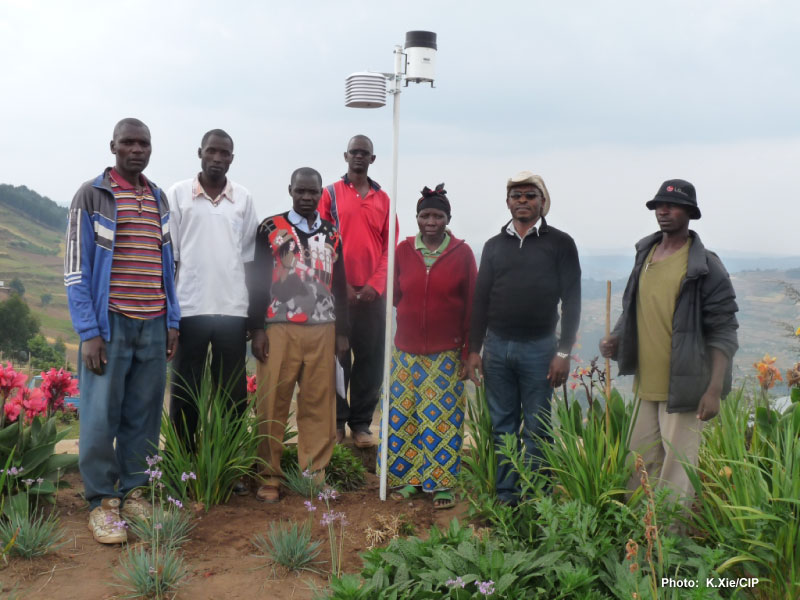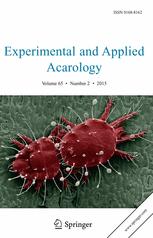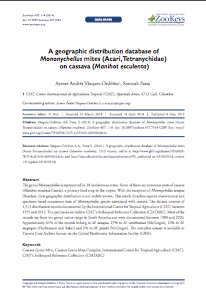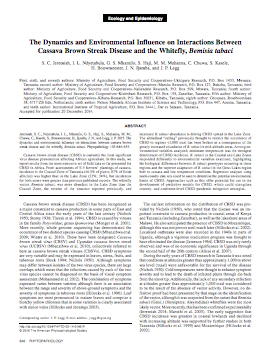Assessment of pest risk under climate change strengthens management

The project team stand by a weather station used to collect data for the project
Pests and diseases already pose major threats to the food security and livelihoods of smallholders. With climate change, these threats are generally expected to grow and also expand to unaffected areas. However, knowledge is limited about exactly which threats will be more severe and in what geographic areas.
An RTB effort to fill this knowledge gap for critical banana, cassava, potato and sweetpotato pests and diseases in Sub-Saharan Africa has produced data for predicting how those threats will evolve under climate change and strengthened the capacity of government institutions to deal with them today.
RTB centers have begun analyzing data from weather stations and farm surveys at action sites in the Rwanda’s Ruhengeri region and Burundi’s Rusizi Valley while researchers completed laboratory experiments to determine how rising temperatures affect the lifecycles of key pests and disease vectors. Harmonized pest and disease field surveys were carried out at both actions sites during one cropping season, whereas weather data collection has been ongoing since July 2014. The goal is to compile two years of weather and farm data for use in modeling climate change impacts on pest and disease risks.
At the same time, RTB researchers and partners have worked with representatives of national research and regulatory institutions in Burundi, DR Congo, Rwanda and Uganda to strengthen the surveillance of critical pests and diseases and the capacity to elaborate effective responses using pest risk analysis (PRA) documents and pest risk maps. PRA documents and risk maps are important tools for national or regional efforts to prevent the entry of new pests and diseases and help farmers prepare for evolving pest and disease threats.
At a workshop on PRA and surveillance held in Kigali, Rwanda in October 2015, draft PRA documents were developed with national partners for the tomato/potato leaf miner (Tuta absoluta), whitefly-vectored cassava brown streak virus, aphid-vectored banana bunchy top disease (BBTD), banana Xanthomonas wilt (BXW) and the invasive strain of Panama Disease Foc Tr4.
According to Jürgen Kroschel, the project leader and Science Leader for Agroecology and Integrated Pest Management at CIP, RTB’s support of PRA training and elaboration complements efforts by the FAO and the UK Food and Environment Research Agency and Centre for Agriculture and Biosciences International (CABI) to promote the drafting and application of PRA documents by African ministries of agriculture. He added that RTB has improved PRA documents through the addition of pest risk maps, which illustrate potential pest entry and range expansion.
PRA documents drafted at the Kigali workshop have since been refined using data from laboratory and field research. RTB researchers generated data on the prevalence of the major diseases in the region. Bioversity scientists conducted five surveys of BBTD and BXW incidence along altitude gradients in Eastern DR Congo, the Rusizi Valley/Lake Tanganyika area and Western Burundi. IITA scientists conducted biological surveys in Burundi and Rwanda to determine the phenotypic and genetic characteristics of the pathogens responsible for cassava mosaic disease, cassava brown streak disease and BBTD. And CIP researchers completed a thorough analysis of the late blight pathogen Phytophthora infestans population in Kenya and Uganda.
RTB scientists used a number of approaches to assess the risks that major pests pose in the region. CIP researchers used life-table data for T. absoluta to develop a preliminary pest phenology model and risk maps with Insect Life-Cycle Modeling software. Using the program CLIMEX, CIAT researchers developed potential distribution maps for the cassava green mites Mononychellus tanajoa and Mononychellus mcgregori – based on 1,232 occurrence records for M. tanajoa and 99 for M. mcgregori. CIAT researchers submitted distribution records of cassava green mites and cassava whiteflies – major virus vectors – to the Global Biodiversity Information Facility, ensuring open access for modeling purposes. Researchers also developed an interactive database for cassava whiteflies that will be launched in 2016.
Through a combination of scientific research and capacity building, the project will continue to help national authorities to assess and prepare for evolving pest risks so that they can deal with them proactively.
Related links

Potential geographic distribution of two invasive cassava green mites

A geographic distribution database of Mononychellus mites (Acari: Tetranychidae) on cassava (Manihot esculenta)

